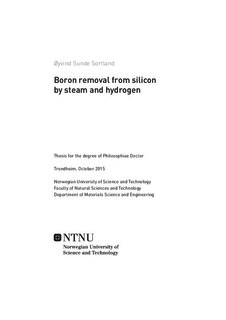Boron removal from silicon by steam and hydrogen
Abstract
Solar cells are among the most promising technologies for development of sustainable power
generation in terms of environmental impact and resource availability, and crystalline silicon
cells dominate the present market expansion. Cost reductions are still necessary for this
technology to become a major global energy producer. Development of metallurgical refining
processes for solar grade silicon has potential to drastically decrease energy consumption,
but face challenges to effectively remove the important impurities boron and phosphorus. For
boron removal, refining by an oxidizing reactive gas show potential for low energy consumption
and promising refining rates.
Previous investigation of reactive gas boron removal is limited, while related plasma refining
has been developed to pilot scale. This experimental study seeks to reveal the potential and
limits of reactive gas refining for boron removal. First and foremost at a fundamental level to
understand the removal process and what determines the rate of removal. Boron was removed
from high-purity silicon and metallurgical grade silicon at 1500-1800 ◦C by blowing steam
in hydrogen and/or argon onto the melt surface. The rate of boron removal was calculated
from inductively coupled plasma mass spectrometry analyzes of the boron content in samples
periodically extracted from the melt. The fastest rate of boron removal was achieved at the
highest gas flow rate. Increasing the partial pressure of steam was also found important to
increase the removal rate and simultaneously reduce gas consumption.
Supply of steam as the oxidizing agent to the interface is the only identified rate determining
step for boron removal, like for active oxidation of silicon to SiO gas at the interface. At
least 50% of the steam in the feed did not reach the surface in representative experiments and
this is attributed to essentially stoichiometric Reactions (0.1) in the gas and (0.2) for active
oxidation of silicon at the interface. Diffusion of steam accounts for increasing losses with
increasing gas flow rate. The fraction of steam in the feed gas that was supplied to the melt
surface was estimated by comparing weightloss by active silicon oxidation in experiments to
equilibrium in Reaction (0.2) if all of the feed gas had reacted.
H2O + SiO = SiO2 (s) + H2 (0.1)
Boron removal in experiments was found to proceed at equilibrium between HBO in the gas
flow and boron in the melt, which was determined from the estimated supply of steam to
the interface Reactions (0.2) and (0.3). No resistance was identified for the mass transfer of
boron as such.
H2O + [Si] −−→
←− SiO + H2 (0.2)
[B] + SiO + 1
2 H2 ¬ HBO + [Si] (0.3)
Equilibrium at the interface also agreed with observations that silica passivation forms if the
steam supply is above the saturation pressure of SiO in Reaction (0.4). Silica formed continuous
layers and stopped boron removal if formed on the entire surface. A clean melt surface
could be maintained with steam partial pressures less than twice the saturation pressure of
SiO at the temperature of the melt. Additionally, CO reacted to SiC particles on the surface
and was found less effective for boron removal than steam. Atmospheric partial pressure
of steam was tested at 1800 ◦C, and exploration of such conditions is suggested for further
developments.
2 SiO ¬ [Si] + SiO2 (s/l) (0.4)
